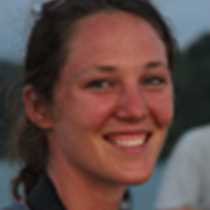Thomas Bay and Petersburg
Alaska is often referred to as the last true wilderness of the United States. Within this vast landscape we can find several species of formidable creatures such as black bears, brown bears, wolves, wolverines, orca, and Steller sea lions. Even moose, although not predatory, deserve recognition as a potentially dangerous animal, especially when protecting their young. Today, however, our fearsome quarry for the morning was none of these large mammals. Instead, we were searching for a small, 2-3 inch-long amphibian called the rough-skinned newt. These newts, whose range extends south to the San Francisco Bay area and north to Southeast Alaska and from elevations of sea level to 9,000 feet, secrete a toxin called tetrodotoxin or TTX. This poison is one of the most potent neurotoxins known to man but helps to protects small creatures such as the rough-skinned newt from larger predators.
Thomas Bay, a picturesque inlet located at the southern end of Frederick Sound, was the destination for our morning walks and an ideal place to search for these elusive rough-skinned newts. The boardwalk trail took us from the rocky beach into a lush temperate rainforest and a short hike brought us to the base of a raging waterfall. The mist from the whitewater sprayed our jackets and faces as we slowly made our way up the slope and past the falls. All eyes were on either side of the trail in hopes of spotting an example of the proclaimed newts. At last, one group was lucky enough to come across one hastening along the path. We kept our distance, though, since its toxin, if ingested, is more than 10,000 times lethal as cyanide. The same tetrodotoxin is found in the puffer-fish, a delicacy that is prepared as sushi in Japan by highly trained chefs. The newts have a bright yellow-orange underbelly, which serves as nature’s warning to its lethality and dissuades any potential predators from snacking. After watching the lone newt until it disappeared beneath a bush, we continued on our way, enjoying the views of the charging river and the rich understory.
For the afternoon, we docked at a small fishing village, situated on Mitkof Island called Petersburg. The town of approximately 3,100 inhabitants relies primarily on fishing as its main source of revenue. We had the opportunity to explore town by bike or foot for several hours and enjoy the feel of a real Alaskan fishing village. A handful of guests also had the privilege of viewing Petersburg and the nearby La Conte glacier from the seats of a floatplane. And finally, across Wrangell Narrows, a channel that separates Mitkof Island from Kupreanof Island, we had the option of walking through a beautiful Alaskan muskeg, or peat bog, and viewing plants and wildlife specific to that habitat.
We ended our day back on board with cocktails and recap. Then for dinner, we were treated to a Dungeness crab feast, picked up fresh in Petersburg, and complete with melted butter and hot towels to wipe our hands.




